The Importance of Grip Strength As We Age
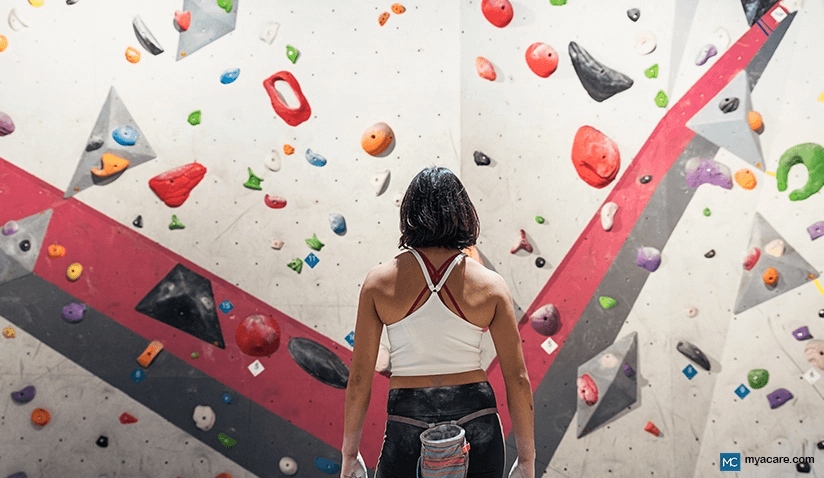
Medically Reviewed by Dr. Rae Osborn, Ph.D. - September 17, 2024
When we shake hands with others, there is often something about the grip of the person that silently speaks about their vitality. That something is likely to be their hand grip strength, which is known to capture a lot about one’s overall health, physical strength and fitness levels.
The following article sheds light on the importance of hand grip strength as we age, factors that may detract from it over time and what can be done to minimize its loss for enhanced aging.

Hand Grip Strength: an Indicator of Physical Function
Hand grip strength is used as a general measure of overall muscle strength (and weakness), which is reflective of overall fitness, coordination and health. The hands can be seen as extensions of the neck, shoulders and spine, with hand grip strength being reflective of one’s posturing, the ability for fine motor control, cardiovascular health and potentially, one’s level of body confidence. Grip strength may also be used to assess lower extremity strength (leg, knee and ankle strength) and can indicate one’s level of mobility, balance and overall postural aptitude.[1]
Naturally, with age, muscle mass declines along with physical activity, predisposing one to lowered hand grip strength. Those with healthier lifestyles tend to have better grip strength for longer and all the anti-aging benefits that accompany it.
8+ Anti-Aging Associations and Benefits of Getting a Grip
Maintaining a strong, healthy hand grip bears associations with longevity and preserved physical functionality throughout life.
The following points describe several of the known benefits of having good grip strength while aging:
- Reduced Risk of Falls and Fractures. The hands can directly protect against falling and fractures due to being able to minimize the impact when falling (i.e., landing on the hands) as well as being able to grasp onto nearby structures. A certain degree of hand grip strength in the elderly is required for getting up and sitting down, particularly when the legs display age-related muscle weakness. Hand grip strength is also indicative of lower extremity strength. The legs, knees and especially the ankles are largely responsible for the majority of falls and related fractures in the elderly. A strength increase in the lower extremities of 1 newton-meter per kg of body weight was shown to lower the risk of falls by 20% in nursing home residents.[2] A similar study highlights these findings by demonstrating that women over the age of 65 who fell more frequently had 24% less strength per kg of weight than age-matched women who suffered from falls infrequently.[3]
- Improved Bone Mineral Density. The pull of muscle over bone is known to promote bone growth. Hand grip strength has been associated with enhanced bone mineral density. Also, overall muscle strength is known to be a better indicator of bone density than muscle mass alone.[4]
- Enhanced Posture and Balance. While there are obvious interconnections between posture, balance and fall risk, and postural control and hand grip strength, it is interesting to note that enhancing grip strength can improve poor posture. Pole dancing is one form of exercise that largely relies on hand grip strength in relation to core muscle control. In a small trial conducted on 52 pole dancers, it was shown that postural stability was the best in the most advanced dancers, who maintained the highest degree of grip strength.[5]
- Linked with Better Cognitive Ability During Aging. Due to the connection between physical fitness, cardiovascular function and cognition, hand grip strength may be a predictor of age-related cognitive decline and related diseases. A number of reviews have demonstrated a link between stronger hand grip scores and improved cognitive abilities in older adults. The parameters of cognition tested were overall cognition, short and long-term memory, language ability and concentration span.[6] Those with higher grip strengths may also be at a lower risk for contracting dementia, as evidenced in small-scale studies.[7] Secondary to optimal cognition would be mood. Reduced hand grip strength may also serve as an indicator of depressive symptoms irrespective of health, age or gender.[8]
- Lower Hospitalization, Complication and Recovery Rates. Lower muscle and grip strength, as well as sit-to-stand time and walking speeds, were shown to be related to a greater risk for all-cause hospitalization across several global populations. Grip strength may be a viable predictor for post-surgical complications, particularly in patients with liver disease, cancer patients and those with cardiovascular disease who require corrective surgery. Weakness, as represented by lower grip strength, may also predispose patients to longer hospitalization and recovery periods.[9]
- Longevity and All-Cause Mortality. One large analysis of over half a million individuals identified hand grip strength as a prominent indicator of longevity. Those with lower grip strength were at an increased risk for premature and all-cause mortality, cardiovascular and respiratory diseases, as well as various forms of cancer.[10] The nature of these specific conditions often predisposes individuals towards muscle wasting and may speed up age-related sarcopenia. A smaller, more experimental study has linked lower hand grip strength to genetic markers for age acceleration and increased biological aging.[11] Following these observations, hand grip strength has been shown to be better in those with less systemic bodily inflammation[12] [13] as well as those who consume a nutrient-dense diet high in foods that lower inflammation.
- Reduced Risk of Cardiometabolic Disease. Several large-scale studies have managed to show that having an improved hand grip strength is modestly associated with a lower prevalence of cardiometabolic disease, including diabetes, cardiovascular disease, metabolic syndrome and heart attacks. Those with better grip strengths tended to have lower levels of triglycerides, reduced blood glucose and insulin levels, higher HDL levels and healthier blood pressure than those with weaker grip strengths.[14] Individuals who were overweight and obese throughout their lives were shown to be at a greater risk of having low grip strength when older.[15]
- Quality of Life. The quality of life is substantially improved in older adults with higher grip strength.[16] [17] As indicated throughout the above points, this finding is likely attributable to better overall fitness and cardiovascular health, which in turn relates to having a better mood and being more active in general. In the elderly, this extends to having more physical functionality for a longer time, which is connected to independence and enhanced life satisfaction. Hand grip strength is associated with an improved ability to carry out basic activities of daily living in older adults, including cooking, driving, map navigation, managing money, shopping and using a phone.[18]
Factors Affecting Grip Strength
While a lack of physical activity is the most obvious cause for reduced muscle strength, there are a few more factors that can detract from grip strength overall. These include:
- Force Generation and Contractile Speed have been linked with an increased risk of falls and fractures. Age-related muscle changes in the elderly have been shown to be related to lower muscle contractile speed, overall strength and force generation, and that these variables occur after the depolarization and subsequent contraction of muscle tissue.[19] This implies the elderly do not necessarily have reduced reflexes or neurologically-induced weakness. Studies suggest that these problems are likely related to age-related vascular changes.
- Gender and Muscle Mass. Women are at a higher risk for falls and fractures due to having a lower muscle mass with less strength on average than men. Even amongst individuals who are similarly fit, strong and healthy, age-related muscle changes will have a more pronounced impact on females than males, with symptoms of sarcopenia revealing themselves sooner on average.
- Positioning and Posture. Studies have shown that one’s position and posture can add or detract from grip strength. In some studies, sitting and standing do not seem to pose a difference with regard to grip strength[20], while in other studies, standing appears to increase grip strength considerably.[21] The results implied that better posture might enhance hand grip strength, with standing usually promoting the best posture. Other studies revealed that sitting or standing with full extension of the elbows proved to increase hand grip strength more than either position with elbows bent at a 90-degree angle[22]. One study revealed that turning of the head towards the left side can have a substantial effect on lowering hand grip strength compared to neutral or right-sided positioning.[23]
- Hand Dominance. For most people, the dominant hand is the right hand. There appears to be an association between hand dominance and grip strength, with the most-used hand having more power than the less-used hand on average[24]. Interestingly, it was shown that one-third of 21 left-handed individuals had stronger hand grip strengths in their right hands, compared to 11% of the 128 right-handed counterparts with stronger left hands. This suggests that a larger percentage of left-handed individuals are ambidextrous than right-handed individuals.
- Smartphone Over-Use. In a small-scale trial conducted on 241 participants, an association between smartphone use and weaker grip strength became apparent. Those who spent more time on their cellphones tended to have weaker hand grips than those that spent less time[25]. This indicates that improving overall muscle strength is more important in the current modern era due to an increasing reliance on technology.
- Diet and Lifestyle. Regular physical activity and a nutritionally-balanced diet are associated with improved handgrip strength in both healthy individuals and those with chronic lifestyle diseases[26]. Those with metabolic and muscle-wasting diseases as well as musculoskeletal disorders, often maintain a lower hand grip strength with a higher degree of inflammation that is usually associated with some form of malnutrition or related metabolic deficit. While the current data is limited, it appears that a long-term higher intake of omega-3 fats[27] [28], vitamin C, fiber-rich foods[29] and anti-inflammatory foods such as garlic[30] were associated with improved hand grip strength. As vascular inflammation and albumin status have been linked with weaker grip strength[31], opting for a diet lower in AGEs may prove beneficial for overall muscle strength and fitness.
- Sleep Quality and Duration. There is a small connection between lower hand grip strength and sleep disturbance and reduced sleep quality[32], yet not insomnia[33]. A larger association was shown to exist between longer sleep duration and grip strength in older adults[34], suggesting that oversleeping is more problematic for overall muscle strength than getting less sleep. While this affects both men and women, some studies suggest that grip strength is much weaker in men who oversleep than in women[35]. Oversleeping can be a sign of muscle weakness and exhaustion, which can be helped by engaging in more physical activity, healthy management of stress levels and consuming a healthier diet.
Types of Exercises for Improving Grip Strength
Lifetime Physical Activity Contributes To Preserved Grip Strength. As hand grip strength is a marker of overall muscle strength, any form of exercise is capable of increasing hand grip strength. Exercising has cumulative long-term health benefits. The longer one is physically active in their life, the more enduring the benefits, which extend to a preserved hand grip strength.
Muscle Strength Can Be Built at Almost All Ages. While those who have maintained an active lifestyle tend to have better muscle strength for a longer time, studies have revealed that grip strength and overall muscle power can be improved in most individuals at any age[36] [37]. In a small study on elderly individuals in their 60s, 12 weeks of strength training served to improve hand grip strength as well as the time it took for participants to stand up from sitting.[38] Those with musculoskeletal and inflammatory diseases such as arthritis can also benefit from improving their hand grip strength through exercising the hands and wrists.[39] [40] Improving grip strength has also been acknowledged as an important intervention for those at high risk for developing age-related sarcopenia, including kidney dialysis patients[41].
Best Exercises for Improving Hand Grip Strength. Naturally, hand grip strength can be improved directly by exercising the hands, wrists, and all parts of the arms and shoulders. Secondary to building muscles that directly support grip strength, developing the strength of the core muscles in the abdomen and spine will indirectly support grip strength. Core muscle and hand grip strength can be enhanced through weight-bearing and resistance exercises that work these muscle groups. Foundational to the core muscles would be cardiorespiratory fitness, which can be improved with deep breathing and aerobic exercises that enhance oxygenation, elevate the heart rate and get the blood moving.
Below are examples of exercises that can help improve hand grip strength:
- Warming-Up From Head to Toe. Before attempting any intensive form of exercise, it is important to loosen the joints and warm the body up. As it happens, many stretches and warm-ups can actually contribute towards improved grip strength by working muscle groups that may be skipped during conventional forms of exercise. When warming up, it is good to start with the feet, loosening the joints and stretching all the muscles through the legs, abdomen, upper body, arms, hands and neck. Special attention ought to be paid to the hands and feet, as they help to improve endurance by maintaining temperature control. Wrist and finger exercises, such as flexing and extending the wrists and fingers in various positions, have been shown to boost grip strength directly afterward[42]. These ought to be mandatory prior to attempting intensive grip strength workouts, such as pull-ups.
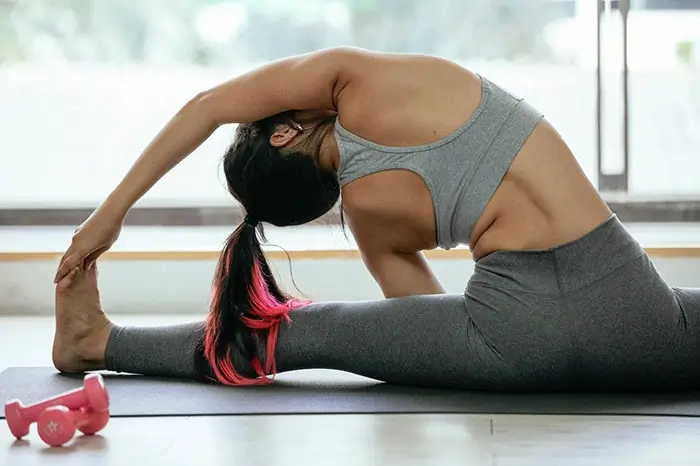
- Weight-Bearing and Core Muscle Exercises. Before tackling the hands and arms with exercises that directly improve grip strength, exercises for the core muscles ought to be practiced first to minimize the risk of injury. It is good to place emphasis on improving the muscles in the lower and upper back, the diaphragm and the shoulders. Sit-ups, push-ups, various back stretches and practicing sitting upright for as long as possible can all contribute towards preliminary core muscle strength before moving on to pull-ups and more intensive weight-lifting with dumbbells. Many warm-up exercises that involve stretching the feet, legs and abdomen also work the back muscles and help to lay the foundation for building proper hand and arm strength.

- Pull-Ups and Dead Hanging are easy and obvious exercises one can use to increase hand grip strength, as well as focus on building arm muscles and getting a great posture. Most people can not do a pull-up at first, which is where dead hanging is a good place to start. Performing a dead hang is as simple as it sounds; one merely hangs from a bar for set intervals at a time. Eventually, dead hanging builds the muscle power required to do a pull-up. It is important to start very small such as hanging for a few seconds at a time, resting for longer than one hangs in between and to scale up the hang time when able. Hanging for too long in one position can cause arm and shoulder injuries. It is also advisable to practice dead hanging with the arms bent at different angles to take the strain off the shoulders and to work a more diverse muscle set. Those who do not exercise regularly may want to do some weight-lifting and other weight-bearing exercises before attempting either pull-ups or dead hanging. Despite the risks, those with a relevant musculoskeletal disorder were shown to have less shoulder pain when they engaged in similar grip-strengthening exercises.[43]
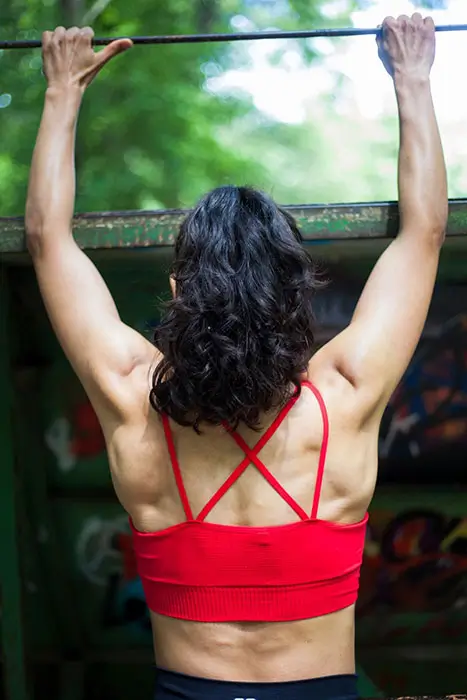
- Fingerboarding and Vertical Climbing. The ultimate evolution of dead hangs and pull-ups would be rock climbing. Rock climbing is a fun, physically-engaging activity that directly enhances grip strength and works many core muscles[44]. Fingerboarding is a type of preliminary climbing exercise that serves to increase the strength of the fingers as well as their grasp, effectively upping hand grip strength[45]. To fingerboard, one needs a fingerboard, which typically resembles a flat bar fixed to a wall that one can use to grip and hang from. Fingerboards are made to practice different hand postures that arise during rock climbing and fingerboarding can be seen as an ultimate type of dead hang. Fingerboarding should be avoided until one can successfully perform dead hangs and pull-ups.
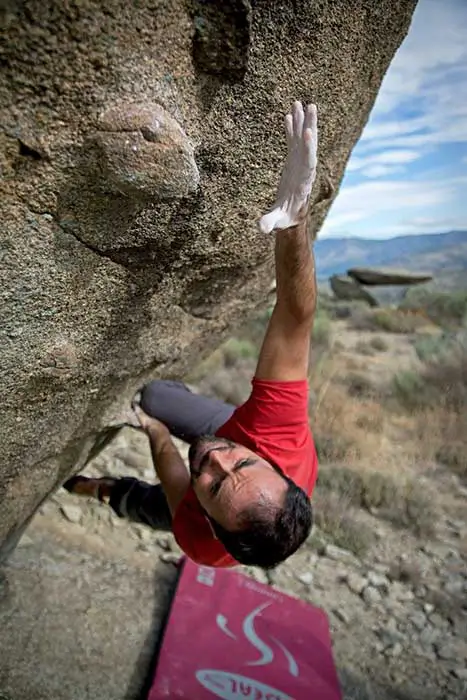
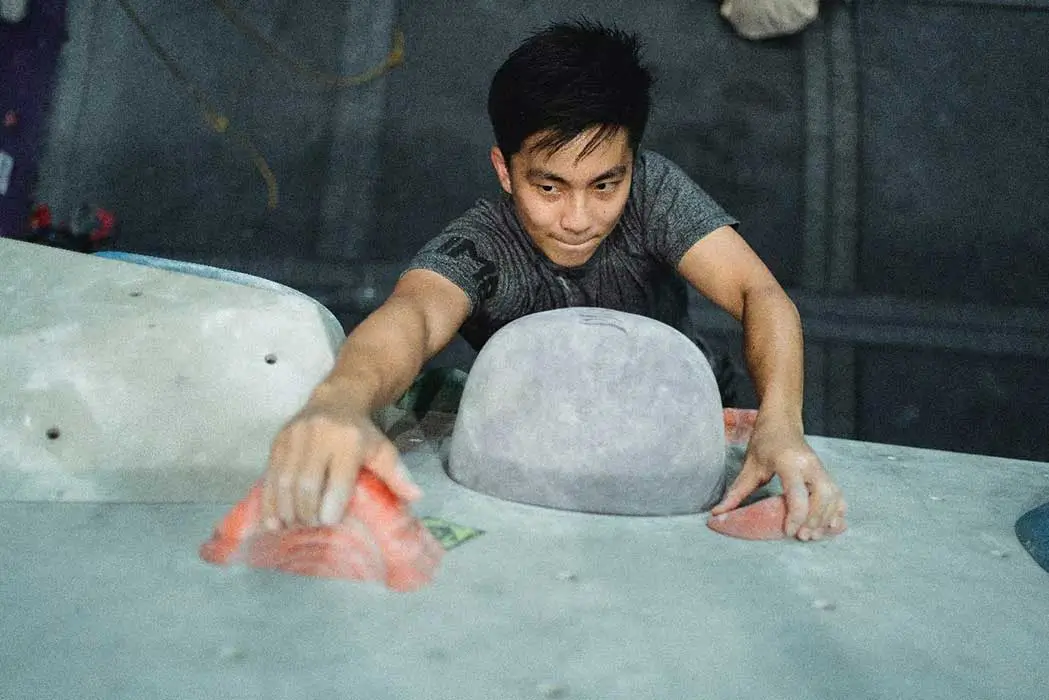
- Shifting Hand, Wrist and Finger Positions During Exercises. Studies have shown that during weight-bearing exercises, such as push-ups, dead hangs, pull-ups and fingerboarding, different arm muscles can be built by shifting the position of the hands and fingers.[46] [47] Once a basic level of proficiency has been achieved with the above exercises, their intensity and difficulty can be increased by rotating the wrists to the opposite orientation, closing or opening the palms and extending fingers.

Conclusion
The hands may be far more revealing than one’s body shape, as shown through hand grip strength. Weak hands can be a sign of physical unfitness, weakness, a higher risk for age-related diseases and reduced mobility, as well as a lower quality of life while aging. Leading an unhealthy, sedentary lifestyle can serve to lower hand grip strength, while working at one’s overall core muscle fitness can enhance it, irrespective of one’s age or health status. Coupled with a nutrient-dense diet plan, exercises that serve to improve posture and core abdominal muscle strength, as well as those that work the arms, wrists, hands and fingers are all known to boost grip strength.
To search for the best healthcare providers worldwide, please use the Mya Care search engine.
The Mya Care Editorial Team comprises medical doctors and qualified professionals with a background in healthcare, dedicated to delivering trustworthy, evidence-based health content.
Our team draws on authoritative sources, including systematic reviews published in top-tier medical journals, the latest academic and professional books by renowned experts, and official guidelines from authoritative global health organizations. This rigorous process ensures every article reflects current medical standards and is regularly updated to include the latest healthcare insights.

Dr. Rae Osborn has a Ph.D. in Biology from the University of Texas at Arlington. She was a tenured Associate Professor of Biology at Northwestern State University, where she taught many courses to Pre-nursing and Pre-medical students. She has written extensively on medical conditions and healthy lifestyle topics, including nutrition. She is from South Africa but lived and taught in the United States for 18 years.
Sources:
Featured Blogs



